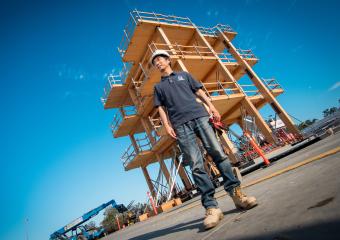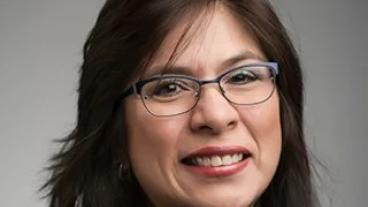Mines researchers aim to get “earthquake proof” lateral system for tall wood buildings added to U.S. building code

Shiling Pei, associate professor of civil and environmental engineering at Mines, poses during the construction of the 10-story mass timber building on the outdoor shake table at the University of California San Diego. (Photo by David Baillot/University of California San Diego)
Seismic testing has been completed on a 10-story mass timber building – the world’s tallest full-scale building ever tested on an earthquake simulator.
Over the course of a month last year, the building withstood 100 tests on the University of California San Diego outdoor shake table, including 88 earthquake-scale shakes of varying magnitude – with no visible structural damage.
“That’s the equivalent of about 10,000 years' worth of earthquake events in the Seattle area,” said Shiling Pei, associate professor of civil and environmental engineering at Colorado School of Mines and lead investigator on the Natural Hazards Engineering Research Infrastructure (NHERI) TallWood project. “Structurally, the test program provided solid proof that a tall mass timber building can achieve the goal of being ‘earthquake proof’ if designed correctly.”
Now, Pei and his research team are moving onto the next phase of the project: Making the case for adding the tall wood building’s innovative rocking wall lateral system to the U.S. design code.
With funding from the Charles Pankow Foundation and the U.S. Forest Service, researchers have begun a FEMA P695 study on the mass timber rocking wall lateral system, the first step toward submitting a proposal for an official building code update. The goal is to get the advanced lateral system included in the 2028 revisions of ASCE-7, the nationally adopted loading standard for general structural design in the U.S.
“The test was great – it provided the ultimate validation of the design – but in order to actually change the building code, a test isn’t enough,” Pei said. “This is the next step.”
Consulted by local building officials nationwide, the ASCE-7 is updated every six years. The document includes a variety of recognized lateral systems – things like concrete or steel walls – in a table that the designers can readily choose from.
While designers and architects can use lateral systems not included in that table, to do so they must conduct additional testing and provide an independent peer-review of the design, at their own expense.
“If it’s not a code-recognized system, the cost of actually using it will be higher for the owner and designer. Even if the system is good, because of that reason, you can’t use it freely,” Pei said. “But by getting the rocking wall system added to the code, we’ll be able to compete with other alternative systems on an equal footing.”
Designed for resilience performance – minimal damage from design-level earthquakes and quickly repairable after rare earthquakes – the rocking wall system consists of a solid wood wall panel anchored to the ground using steel cables or rods with large tension forces in them. When exposed to lateral forces, the wood wall panels are designed to rock back and forth – which reduces earthquake impacts – and then the steel rods pull the building back to plumb once the earthquake passes.
Rocking walls have been used before in smaller, 3- to 4-story buildings – but never at the 10-story scale proposed by the NHERI TallWood project, Pei said.
With the next round of ASCE-7 changes set to be adopted in 2028, Pei and his team will spend the next two years collaborating with KPFF to submit the needed code-change proposals.
At Mines, the team is focusing on developing numerical models and conducting simulations that will qualify the system for the design code. The collaborating team at KPFF will oversee the logistics of the required peer review process and the transformation of the team’s research findings into code language.
The Charles Pankow Foundation has funded similar projects in the past, including two successful efforts to add other innovative lateral systems to the U.S. design code. The private and independent public benefit foundation serves a unique role in the architecture, engineering, and construction industry, providing leadership and catalytic funding to support game-changing research and industry collaborations to transform the industry.
“The foundation is excited for this research project to establish mass timber rocking wall lateral systems in our design code,” said Rik Kunnath, president of the Charles Pankow Foundation. “The implications for seismic resiliency are important and one of the several reasons the foundation is proud to be sponsoring this innovative research for building design and construction.”




